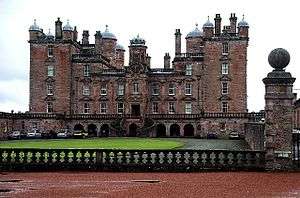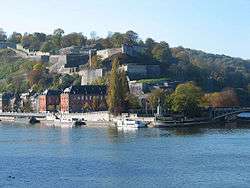James Douglas (English Army officer)
Lieutenant-General James Douglas (1645–1691), younger brother of the Duke of Queensberry, was a Scottish military officer.
Lieutenant-General James Douglas | |
|---|---|
 Drumlanrig Castle, the Queensberry estate; constructed between 1679 and 1689 | |
| Born | 1645 Drumlanrig Castle, Dumfriesshire |
| Died | December 1691 (aged 45–46) Namur, Spanish Netherlands |
| Allegiance | |
| Service/ | Infantry |
| Years of service | 1672–1691 |
| Rank | Lieutenant-General |
| Unit | Lockhart's Regiment 1672–1674 Dutch Scots Brigade 1674–1684 Scots Footguards, 1684–1691 |
| Commands held | Master-General of the Ordnance, Scotland October 1685 – March 1688 Commander in Chief, Scotland March – November 1688 |
| Battles/wars | Third Anglo-Dutch War 1672–1674 Franco-Dutch War 1674–1678 Maastricht; Cassel; Saint-Denis Scotland Battle of Bothwell Bridge 1679 Argyll's Rising 1685 Williamite War in Ireland 1689–1691 The Boyne; Athlone 1690 |
From 1672 to 1684, he served in the French army and the Dutch Scots Brigade, before being appointed Commander in Chief for Scotland by James II. After James was replaced by William III in the November 1688 Glorious Revolution, he held a number of senior commands in the 1689–1691 Williamite War in Ireland. He was transferred to the Low Countries in late 1690 to serve in the Nine Years War, and died of fever at Namur in 1691.
Biography
James Douglas was the second son of James Douglas, 2nd Earl of Queensberry (c. 1610 – 1671) and his wife Lady Margaret Stewart. The Earl signed the 1638 National Covenant, but took little part in the 1639–1651 Wars of the Three Kingdoms; arrested in 1645 for attempting to join Montrose's Royalist campaign, he was released after paying a fine.[1] The Douglas family largely retained its position and estates through the various changes of regime in the 17th century.[2]
He married Anna Hamilton and they had two sons, James and William.[3] James received a commission in his father's regiment in 1688 but resigned in October 1691 and died in 1700; William died in 1712.[4]
Career
As a result of the Wars of the Three Kingdoms, many in both Scotland and England viewed standing armies as a threat to individual liberty and society itself.[5] Those who wanted a military career joined units in foreign service, such as the Dutch Scots Brigade; loyalties were often based on religion or personal relationships, with officers moving between armies. Douglas' younger brother John (1647–1675) was killed at Trier with the French army, while Robert (1650-1676) died serving with the Dutch at Maastricht.[1]

In the 1670 Treaty of Dover, Charles II signed an alliance with Louis XIV against the Dutch Republic.[6] Charles also agreed to supply the French army with a brigade of 6,000 men; in a secret provision not revealed until 1771, Louis agreed to pay him £230,000 per year for this.[7]
On the outbreak of the Third Anglo-Dutch War in 1672, James Douglas was appointed Captain in Sir William Lockhart's Regiment, which formed part of the expeditionary force for a proposed landing in the Dutch Republic. When this plan was cancelled in 1673, Lockhart's joined the rest of the Brigade in the Rhineland, under the command of the Duke of Monmouth, Charles' illegitimate son.[8] However, the alliance with Catholic France was deeply unpopular and England withdrew from the war with the 1674 Treaty of Westminster.[9]
The Franco-Dutch War continued and to keep his French subsidies, Charles encouraged members of the Brigade to remain in French service; others enrolled in the Dutch Scots Brigade, including Douglas and a fellow officer in Lockhart's Regiment, John Graham, later Viscount Dundee.[10] Despite the name, the Scots Brigade normally contained several English regiments, withdrawn in 1672 then restored in 1674. One of these was Colyear's Regiment, which Douglas joined along with his brother Robert; a Lieutenant-Colonel when the war ended in August 1678, he was promoted Colonel in March 1680.[11]
%2C_prins_van_Oranje._Stadhouder%2C_sedert_1689_tevens_koning_van_Engeland_Rijksmuseum_SK-A-1228.jpeg)
Douglas was in Scotland during the 1679 Covenanter rebellion, and took part in the Battle of Bothwell Bridge that ended it. As a reward, he was granted the lands of Patrick Murdock of Cumloden, one of those convicted for their participation, later tconfirmed in April 1685.[12]
Scottish politics was dominated by Douglas' elder brother, the Marquess of Queensberry, who was appointed Treasurer of Scotland in 1682.[13] To offset his rival Dundee, then military commander in Scotland, Queensberry needed a reliable subordinate; in June 1684, he persuaded the Earl of Linlithgow to step aside as Colonel of the Scots Footguards in favour of his younger brother, who returned to Scotland permanently.[14]
He played an active role in the suppression of Argyll's Rising; the Tweedsmuir cemetery contains a memorial to John Hunter, cruelly murdered at Core Head by Col. James Douglas and his party for his adherence to the Word of God and Scotland’s Covenanted Work of Reformation 1685.[15] In October, William Drummond, Viscount Strathallan was appointed Commander-in-Chief, Scotland, with James as Master-General of the Ordnance.[16]
James II succeeded Charles in April 1685 with widespread support in both countries; the religious conflicts of the 17th century meant most Scots saw both dissident Presbyterians and Catholics as threats and opposed 'tolerance' for either, one reason why Argyll's Rising collapsed so quickly in June 1685.[17] After Strathallan died in March 1688, Douglas assumed the position of Commander-in-Chief but it is not clear whether he was ever officially appointed as such and operational control was largely exercised by Dundee.[18]

In 1685, many supported James from fear of civil war if he were bypassed; by July 1688, anti-Catholic riots made it seem only his removal could prevent one.[19] Just before the 1688 Glorious Revolution, the Scottish army was brought south to join the rest of James' forces in England. After William III of England landed in Brixham on 5 November, his troops deserted and he went into exile on 23 December.[20]
In March, 1689, James II launched the 1689–1691 Williamite War in Ireland; Douglas joined the army in Ireland and was replaced as Commander in Scotland by Sir Hugh Mackay, another former colleague.[21] He commanded a brigade at the Battle of the Boyne in July 1690, and supervised the First Siege of Athlone; William viewed its failure as a missed opportunity to end the war in Ireland. In May 1691, Douglas was posted to the Low Countries to serve in the Nine Years War, along with two other senior officers involved, Percy Kirke and Sir John Lanier.[22]
Within a year, all three were dead; Douglas died of disease at Namur in July 1691, Kirke at Brussels in October, while Lanier was killed at Steenkerque in August 1692.[23] He was succeeded as Colonel of the Foot Guards by George Ramsay, another former Scots Brigade colleague.[24]
References
- Le Neve 1712, p. 456.
- Debrett 1814, p. 637.
- Balfour 1910, p. 136.
- Dalton 1909, p. 87.
- Childs 1987, p. 184.
- Lynn 1996, pp. 109–110.
- Kenyon 1993, pp. 67-68.
- Childs 1984, p. 388.
- Davenport 1917, p. 238.
- Linklater 2004.
- Dalton 1909, pp. 78-78.
- "Ratification in favour of Colonel James Douglas and Robert Barton". Parliamentary Register. Retrieved 14 October 2018.
- Ford 2004.
- Dalton 1909, p. 51.
- Dumfries and Galloway Council.
- Dalton 1909, p. 74.
- Harris 2007, pp. 153–157.
- Childs 2008, pp. 232–234.
- Wormsley 2015, p. 189.
- Harris 2007, pp. 3-5.
- Macpherson 1775, pp. 357–358.
- Childs 1994, p. 293.
- Dalton 1909, p. 86.
- British Empire.
Sources
- Balfour, James (1910). The Scots Peerage.CS1 maint: ref=harv (link)
- British Empire. "Colonels in the 3rd Regiment of Footguards". British Empire. Retrieved 7 October 2018.
- Childs, John (1994). Chandler, Beckett (ed.). The Restoration Army 1660-1702 in The Oxford History of the British Army (1996 ed.). OUP. ISBN 978-0192803115.CS1 maint: ref=harv (link)
- Childs, John (1987). The British Army of William III, 1689-1702. Manchester University Press. ISBN 978-0719025525.CS1 maint: ref=harv (link)
- Childs, John (1984). "The British Brigade in France 1672-1678". History. 69 (227). JSTOR 24419689.CS1 maint: ref=harv (link)
- Childs, John (2008). The Williamite Wars in Ireland. Bloomsbury 3PL. ISBN 978-1847251640.CS1 maint: ref=harv (link)
- Dalton, Charles (1909). The Scots Army 1661-1688. Eyre & Spottiswoode.CS1 maint: ref=harv (link)
- Davenport, Frances Gardiner (1917). European Treaties bearing on the History of the United States and its Dependencies.CS1 maint: ref=harv (link)
- Debrett, John (1814). Peerage of the United Kingdom; Volume II, Scotland and Ireland. F. C. and J. Rivington and others.
- Dumfries and Galloway Council. "The Killing Times" (PDF). Southern Upland Way. Retrieved 14 October 2018.
- Ford, JD (2004). "Douglas, William, first duke of Queensberry (1637–1695)". Oxford Dictionary of National Biography (online ed.). Oxford University Press. doi:10.1093/ref:odnb/7936. (Subscription or UK public library membership required.)
- Harris, Tim (2007). Revolution; the Great Crisis of the British Monarchy 1685-1720. Penguin. ISBN 978-0141016528.CS1 maint: ref=harv (link)
- Kenyon, JP (1986). The History Men: The Historical Profession in England since the Renaissance (1993 ed.). Weidenfeld & Nicolson.CS1 maint: ref=harv (link)
- Lynn, John (1996). The Wars of Louis XIV, 1667-1714 (Modern Wars in Perspective). Longman. ISBN 978-0582056299.CS1 maint: ref=harv (link)
- Le Neve, John (1712). Memoirs British and Foreign, of the Lives and Families of the Most Illustrious Persons (2015 ed.). Arkose Press. ISBN 978-1345713763.CS1 maint: ref=harv (link);
- Linklater, Magnus (2004). "Graham, John, first viscount of Dundee [known as Bonnie Dundee]". Oxford Dictionary of National Biography (online ed.). Oxford University Press. doi:10.1093/ref:odnb/11208. (Subscription or UK public library membership required.)
- Macpherson, James (1775). Original Papers: Containing the Secret History of Great Britain (2017 ed.). Hansebooks. ISBN 978-3-7434-3572-8.CS1 maint: ref=harv (link)
- Wormsley, David (2015). James II: The Last Catholic King. Allen Lane. ISBN 978-0141977065.CS1 maint: ref=harv (link)
| Military offices | ||
|---|---|---|
| Preceded by Viscount Strathallan |
Commander-in-Chief, Scotland April 1688–December 1688 |
Succeeded by Hugh Mackay |
| Preceded by The Earl of Linlithgow |
Colonel of the Scots Regiment of Foot Guards 1684–1691 |
Succeeded by Hon. George Ramsay |
| Preceded by Alexander Colyear |
Colonel of the Third Scottish Regiment, Dutch Scots Brigade 1680–1684 |
Succeeded by John Wauchope |